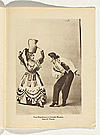Pablo PICASSO

Pablo Ruiz Picasso (b Málaga, Spain, 25 October 1881 – d Mougins, France, 8 April 1973) initially was taught by his father at the School of Fine Arts in Málaga. Later he studied at the School of Fine Arts in La Coruña, in Barcelona, and the Royal Academy of San Fernando. During his long career Picasso’s style often changed dramatically—Blue period (1901–04); Rose period (1904–06); Primitive period (1907–09); Analytic Cubism (1909– 12); Synthetic Cubism (1912–19); Neoclassical period (1920s); Surrealist period (1930s).
Picasso was introduced to Diaghilev by Jean Cocteau in 1916, leading to his first ballet commission, for Parade (1917). Picasso further immersed himself in the world of the Ballets Russes by marrying one of the principal dancers, Olga Khokhlova. Over the years he had several long relationships, and married a second time in 1961. Picasso was also commissioned to work on designs for Le Tricorne (1919), Pulcinella (1920)—for which he made three different designs—and Cuadro Flamenco (1921). His sketches of many Ballets Russes members, including choreographers, dancers and Diaghilev, were published in a number of souvenir programs.
In 1924 he worked on a production of the ballet Mercure at the Théâtre de la Cigale for Comte Etienne de Beaumont’s Soirées de Paris. Picasso’s last official design role for the Ballets Russes was the curtain for Le Train bleu (1924), the gouache for which he painted two years earlier. In 1946, Picasso returned to theatre work with another curtain design, this time for Le Rendez-vous for the Ballets des Champs-Elysées.
Brassaï
Picasso in his studio, Rue des Grandes 1939 gelatin silver photograph
36.6 x 27.5 cm National Gallery of Australia, Canberra, purchased 1980, 1980.2615





![Pablo PICASSO | Curtain design for La Boutique Fantastique [Esquisse du rideau de La Boutique Fantastique] / Set for Le Tricorne [Décor du Le Tricorne] | 1919-20](images/sml/203485.jpg)
![Pablo PICASSO | Curtain for Le Tricorne [Rideau pour Le Tricorne] | 1919-20](images/sml/203479.jpg)







